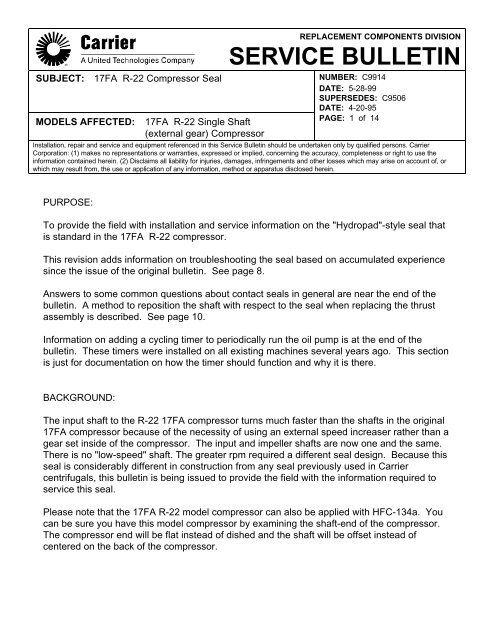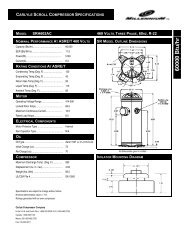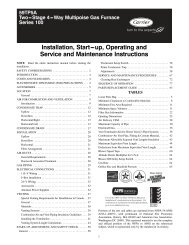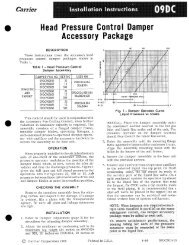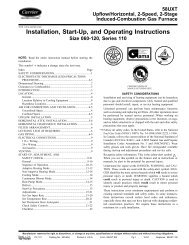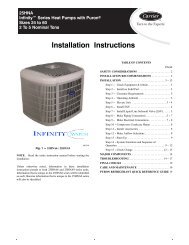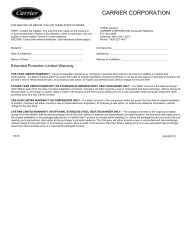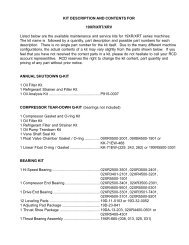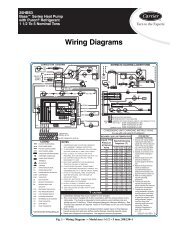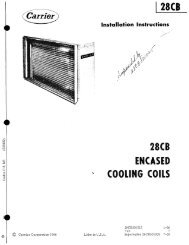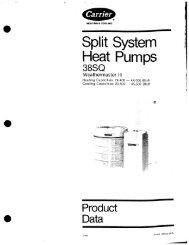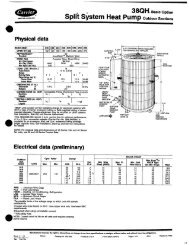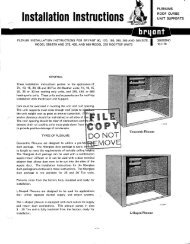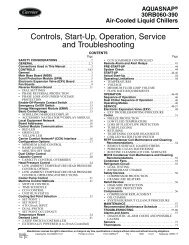SERVICE BULLETIN - Carrier
SERVICE BULLETIN - Carrier
SERVICE BULLETIN - Carrier
Create successful ePaper yourself
Turn your PDF publications into a flip-book with our unique Google optimized e-Paper software.
REPLACEMENT COMPONENTS DIVISION<strong>SERVICE</strong> <strong>BULLETIN</strong>SUBJECT: 17FA R-22 Compressor Seal NUMBER: C9914DATE: 5-28-99SUPERSEDES: C9506DATE: 4-20-95MODELS AFFECTED:17FA R-22 Single Shaft(external gear) CompressorPAGE: 1 of 14Installation, repair and service and equipment referenced in this Service Bulletin should be undertaken only by qualified persons. <strong>Carrier</strong>Corporation: (1) makes no representations or warranties, expressed or implied, concerning the accuracy, completeness or right to use theinformation contained herein. (2) Disclaims all liability for injuries, damages, infringements and other losses which may arise on account of, orwhich may result from, the use or application of any information, method or apparatus disclosed herein.PURPOSE:To provide the field with installation and service information on the "Hydropad"-style seal thatis standard in the 17FA R-22 compressor.This revision adds information on troubleshooting the seal based on accumulated experiencesince the issue of the original bulletin. See page 8.Answers to some common questions about contact seals in general are near the end of thebulletin. A method to reposition the shaft with respect to the seal when replacing the thrustassembly is described. See page 10.Information on adding a cycling timer to periodically run the oil pump is at the end of thebulletin. These timers were installed on all existing machines several years ago. This sectionis just for documentation on how the timer should function and why it is there.BACKGROUND:The input shaft to the R-22 17FA compressor turns much faster than the shafts in the original17FA compressor because of the necessity of using an external speed increaser rather than agear set inside of the compressor. The input and impeller shafts are now one and the same.There is no "low-speed" shaft. The greater rpm required a different seal design. Because thisseal is considerably different in construction from any seal previously used in <strong>Carrier</strong>centrifugals, this bulletin is being issued to provide the field with the information required toservice this seal.Please note that the 17FA R-22 model compressor can also be applied with HFC-134a. Youcan be sure you have this model compressor by examining the shaft-end of the compressor.The compressor end will be flat instead of dished and the shaft will be offset instead ofcentered on the back of the compressor.
REPLACEMENT COMPONENTS DIVISION<strong>SERVICE</strong> <strong>BULLETIN</strong><strong>BULLETIN</strong> NUMBER: C9914Page: 2 of 14MACHINES AFFECTED:All 17FA R-22 style (single-shaft) compressors. This includes those used with refrigerantsother than R-22.REPLACEMENT PROCEDURE:NOTE: In the procedure we instruct you to coat the carbons with oil when assembling the seal.Although it has been fairly common practice to assemble seals dry so they will "lap in", thehigh speed of this seal will produce destructive temperatures if started with dry faces. Makesure the faces are lubricated during assembly.1. Examine the seal casings (see fig. 1). When replacing the seal carbons it is NOTnecessary and it is NOT recommended to replace the stainless steel seal casing unless itis damaged (see “Troubleshooting”) or is not the current version (see below). The springand pressure plate which are contained in the casing can easily be replaced withoutreplacing the casing itself. New casings are included with the complete seal package incase they are needed. However, they are difficult to replace and there is nothing to begained by it unless they have been damaged and any damage is usually done while theyare being handled, not during machine operation.The current version of the seal casing is golden yellow in color due to a hard titaniumnitride coating. If the casing was received from RCD after January 1997 or was installed ina machine built after January 1997 then it is the latest casing. In the latter part of 1996some casings were made that were coated with the hard gold coating but the surface onwhich the ID of the Omniseal rides was too rough and caused the Omniseal to hang up ifthe carbon was pushed in and released. If the vintage of the casing is in doubt check forthe possibility of Omniseal hang up and, or wear on the ID of the Omniseal. If either isfound, replace the casing.To install a new seal casing, first replace the o-ring between the outboard seal holder andthe OD of the outboard seal casing. Early machines will not have this o-ring.The seal casings should be cooled as much as possible to ease the press fit. Dippingthem in liquid nitrogen would be ideal. They would drop in place without heating the sealhousing. Filling the casing with a high volatility solvent such as brake cleaner will causethe casing to cool as the solvent evaporates.Heat the outer seal holder to 250° F (no higher or you will damage the o-ring) and thencarefully press the seal casing into the holder until the edge of the casing is exactly flush
REPLACEMENT COMPONENTS DIVISION<strong>SERVICE</strong> <strong>BULLETIN</strong><strong>BULLETIN</strong> NUMBER: C9914Page: 3 of 14with the surface of the seal holder. DO NOT push the casing in until it bottoms in theholder.The inner seal housing can be heated to 700-800° F since there is no o-ring to damage.When pressing the casing into the housing it is important to press the casing evenly. A diskof between 4.7 in.(11.9 cm)& 4.2 in. (10.7 cm) diameter can be used. A blankoff for 4 in.grooved pipe fittings is just the right diameter. Victaulic is a common brand name forgrooved pipe fittings.Once the housings have cooled, turn them face down and drip a thin grade of Loctite intothe knockout holes in the back of the housings. The grade of Loctite used for tube rolling isfine for this purpose. Allow time for the Loctite to wick down into any gap between thecasings and the seal housing. After a few minutes add some more Loctite to each hole.Tape can be applied to the gap between the housing and the casing on the ID as shownbelow. This will minimize the amount of Loctite that runs out and is wasted. Also, if thetape provides a good seal you can tell if sufficient Loctite has been added because thelevel will no longer drop in the knockout holes.Drip Loctite intoKnockout HolesSeal HousingTapeCarbonCasingShrink fit2. If the thrust bearing has been adjusted, perform the steps in the section "ADJUSTING THECARBON WORKING HEIGHT" (see fig. 2). Then proceed to the next step.
REPLACEMENT COMPONENTS DIVISION<strong>SERVICE</strong> <strong>BULLETIN</strong><strong>BULLETIN</strong> NUMBER: C9914Page: 4 of 143. An Omniseal must be installed in each seal casing with the open edge facing the pressureplate (see fig. 1). The rounded edges at the tips (it is U shaped in cross section) are thesealing surfaces. Be careful not to damage these edges with hard objects. Denting theedge with your fingernail can compromise its sealing ability. Do not try to install theOmniseal and carbon simultaneously. Install the Omniseal first.4. Insert the carbon (primary ring) in each seal casing, being careful to line up the 4indentations in the O.D. with the anti-rotation "dents" in the seal casing.Using the mating ring, press the carbon in until the carbon and springs bottom in thecasing. Inspect the ID of the assembly. If a gap can be seen between the Omniseal andthe carbon shoulder, the lip of the Omniseal is not on the carbon ID. Properly assembled,the carbon shoulder will be out of sight in the seal casing.5. Using guide rods fastened into the ¼-20 threaded holes in the inner seal mounting flange,insert the inner seal shims and the inner seal holder and bolt into place.6. Coat the inner carbon surface with oil then install the Mating Ring on the shaft. (Don'tforget the o-ring behind the Mating Ring in the shaft shoulder). Lock the Mating Ring inplace with the threaded shaft sleeve.7. Coat the outer carbon face with oil, then using guide rods threaded into the 3/8-16 holesin the outer seal mounting flange, install the outer seal holder and outer seal shims. Boltinto place. Torque the outer seal mounting bolts to 46-50 ft-lbs.ADJUSTING CARBON WORKING HEIGHT: (refer to fig. 2)The shims that position the inner and outer seal housings must be adjusted to provide thecorrect working height for the carbons. The working height is defined as the gap between theseal casing/holder and the face of the Mating Ring.REQUIRED MEASUREMENTS: (shaft should be in the thrust position)A=Inner seal housing bolt ring thicknessB=Outer seal flange to inner seal flange distance. Use a depth micrometer.C=Outer seal flange to outer surface of the Mating Ring. The Mating Ring must be lockedagainst the shaft shoulder with the spacer sleeve and locknut. Use a depth micrometer. Becareful to not scratch the face of the Mating Ring with the micrometer.D=Outer seal housing face to open end of seal casing, which is flush with the outer sealholder shoulder.
REPLACEMENT COMPONENTS DIVISION<strong>SERVICE</strong> <strong>BULLETIN</strong><strong>BULLETIN</strong> NUMBER: C9914Page: 5 of 14E=Outer seal housing bolt ring thickness.F=Mating Ring thickness (for reference it should 0.625 +-0.008)INNER SHIM THK. = B - (A + C + F + 0.040) tolerance +-0.002OUTER SHIM THK. = D + 0.050 - (C + E) tolerance +-0.002<strong>SERVICE</strong> PARTS PACKAGES:17FA-522-1507 is a complete seal as furnished by John Crane. It contains two primary rings(carbons), two Omniseals, one Mating Ring (rotating ring). The carbons and Omniseals areassembled into seal casings containing the seal springs.Again, it is not recommended that the seal casings be replaced unless there is damage to thecasing or the seal problem can be traced to the casing. Remove the carbons and Omnisealsand install them in the existing seal casings.17FA-522-327 is a kit containing two carbons and two Omniseals. No casings and springs, noMating Ring.17FA-522-1327-1 Individual OmnisealAdditional parts needed when changing a seal: (one each except as noted)Gasket, Seal Cover17FA-522-1226Gasket, Labyrinth17M-421-1811O-ring, Outer seal holder KK-71EW-431O-ring, Shaft shoulderKK-71EW-038O-ring, Inner seal holder KK-71GW-048O-ring, Seal casing KK-71GW-047 (Qty 1) **Shim pkg., Inner seal holder 17FA-522-1486Shim pkg., Outer seal holder 17FA-522-1477**This o-ring was added to the seal assembly in December 1992.
REPLACEMENT COMPONENTS DIVISION<strong>SERVICE</strong> <strong>BULLETIN</strong><strong>BULLETIN</strong> NUMBER: C9914Page: 6 of 14
REPLACEMENT COMPONENTS DIVISION<strong>SERVICE</strong> <strong>BULLETIN</strong><strong>BULLETIN</strong> NUMBER: C9914Page: 7 of 14
REPLACEMENT COMPONENTS DIVISION<strong>SERVICE</strong> <strong>BULLETIN</strong><strong>BULLETIN</strong> NUMBER: C9914Page: 8 of 14TROUBLESHOOTING THE 17FA R-22 STYLE COMPRESSOR SEAL:How does age affect the seal?This seal runs at a very high speed and so accumulated running time is more of a factor thanwith slower shaft speeds. With ideal conditions a design life of roughly 10,000operating hours can be achieved. Each start is equivalent to several hours of operationsince the sealing surfaces are touching as the compressor starts spinning.Symptom - Seal starts leaking refrigerant gas shortly after the oil pump is stopped. Noapparent external oil leakage is noticed prior to the gas leakage.Cause - The oil is draining from the seal internally. This can be caused by a bad innercarbon, axial hang-up of the inner carbon (see below) or a leaking check valve in theseal supply line. This valve can be reached through the inspection cover.Symptom - Intermittent increases in seal oil drip rate and, or an external oil drip at shutdownfollowed by gas discharge.Cause - Axial hang-up of the OUTER seal carbon.Axial carbon hang-up can be caused by foreign matter collecting around the Omniseal, alsoby poor fit between the carbon and the stainless steel seal casing or by a wearing of thecasing anti-rotation “dents” by the harder carbon. If poor fit is the cause you will find thecarbon anti-rotation slot worn right at the corner where the curve of the slot meets the OD ofthe carbon. If the fit is proper the wear or contact area will extend over the arc defined by thearrows in figure 4. If the casing does not have a golden yellow titanium nitride coating, it islikely to be worn by the carbon. Non-yellow casings should always be replaced. This is notjust because of the coating but also because the current carbons have been re-dimensionedto match the changed casings.Proper distance from the tip of a bump to the opposite bump is 3.845 +- .005 in. with thecasing installed in the seal housing. The casing is a shrink fit in the housing so measurementof the bump-to-bump distance is not valid if the casing is not installed in the housing.The carbon to casing clearance can be checked with the carbon and Omniseal installed in thecasing which, in turn, has been installed in the seal housing. The clearance between thecarbon anti-rotation groove and the tip of the casing bump should be .0095/.0145 in.If you find evidence of axial carbon hang-up replace the casings. New casings come with theseal kit 17FA-502-1507.
REPLACEMENT COMPONENTS DIVISION<strong>SERVICE</strong> <strong>BULLETIN</strong><strong>BULLETIN</strong> NUMBER: C9914Page: 9 of 14The original casing was of two piece construction with an insert piece used to form the antirotation“dents”. The current casing design is one solid piece of metal. See fig. 3 for acomparison of the anti rotation dents.Testing for Axial carbon hang-up:Press the carbon into the casing by applying even pressure to two or more places evenlyspaced, then release one side then the other in sequence. The carbon should come back toits original position. If it does not, run a piece of stiff paper around the OD of the carbon. If itcan travel 360° around the carbon without stopping, you can be sure that it is Omniseal tocasing friction that is holding the carbon and the casings should then be replaced.Symptom - Seal performance deteriorates over time.Possible cause - Teflon Omniseal wears on the stainless steel casing producing a flat ID onthe Omniseal and a brownish paste which is a mixture of oil and Teflon powder coating the IDof the Omniseal as shown in figure 5. If this is found replace the casing.
REPLACEMENT COMPONENTS DIVISION<strong>SERVICE</strong> <strong>BULLETIN</strong><strong>BULLETIN</strong> NUMBER: C9914Page: 10 of 14Figure 5Is the compressor shaft concentric to the seal housing?Symptom: High running drip rate and rapid deterioration of the seal.The shaft should be concentric to the seal housing within 0.001 in. or 0.002 in. TIR. Whenchecking this runout, make sure that the dial indicator button is far enough inside the sealhousing to avoid the slight bevel that extends approx. ¼ in. from the edge.If the concentricity is not correct the seal end journal bearing housing will have to berepositioned.COMMONLY ASKED QUESTIONS ABOUT CONTACT SEALS IN GENERAL:(The following is not specific to the 17FA)If a seal starts to blow refrigerant during downtime, how do I prevent the loss of the refrigerantcharge?Start the oil pump and allow the seal to fill with oil. If the seal starts to blow again after a shorttime, leave the oil pump running until the charge can be removed and the seal repaired. If oilshould gush from the seal during this time, spread absorbent and get to work pumping out thecharge. Cleaning the floor costs much less that replacing the charge.If a technician cannot get to the job immediately and the oil sump is getting low, have thecustomer add oil to the sump through the seal oil return pump. Any centrifugal oil will do. Youcan drain the sump later.
REPLACEMENT COMPONENTS DIVISION<strong>SERVICE</strong> <strong>BULLETIN</strong><strong>BULLETIN</strong> NUMBER: C9914Page: 11 of 14How long can the charge be left in the machine without any attention?No more than a day. Here’s why:A contact seal consists of two EXTREMELY flat polished surfaces that are pressed againstone another. Since one has to move with respect to the other they are actually separated bya film of oil. You can look at the seal surface as a very small hole that is filled with oil. Oilbeing thick, it cannot flow through the hole more than a drip at a time. Refrigerant is anextremely small molecule and refrigerant gas could flow rapidly through the seal if oil was notin the way. Thus, oil will slowly leave the seal and as soon as part of the seal surface isuncovered refrigerant will escape.The length of time it will take for this to happen can vary greatly. A low pressure machine witha small surface can sit for weeks. With high pressure refrigerant the force trying to push theoil reserve through the seal is much greater. Larger shaft diameters resulting in larger sealcircumferences will also reduce the amount of time that a seal will hold after the oil supply isstopped. Although the seal could hold for several days, it is foolish to risk leaving the chargeunattended. Run the oil pump daily and visually monitor the seal. Better yet, pump themachine down to zero psig (zero kPa) if it will be idle for several weeks.How do I know if a seal must be repaired? Ask yourself these questions:Does the seal drip oil during shutdown periods at a rate greater than one drop every 10-15minutes?Whatever the shutdown drip rate, will the seal prevent refrigerant from escaping for at least 24hours?Does oil escape from the seal during operation at a rate great enough that some oil leaks outof the seal labyrinth instead of flowing to the seal oil return chamber?Is the seal drip rate increasing daily or weekly or is it holding steady?Now that you have asked those questions consider these statements.During run-in at the factory a seal must hold to a specification of 50-75 drops/min. dependingon the seal and when the specs were written. The oil sump is at atmospheric pressure andthe parts are all new and (we hope) perfect. You certainly don’t have these conditions when aseal is running.An FA 57-59 heat exchanger combination contains roughly 50 lbs. of R-22 when at a 20"vacuum level. A seal dripping 70 drops/min running 10 hrs/day 260 days/yr. will emit roughly
REPLACEMENT COMPONENTS DIVISION<strong>SERVICE</strong> <strong>BULLETIN</strong><strong>BULLETIN</strong> NUMBER: C9914Page: 12 of 1458 lbs of R-22 for that year in “de minimis” release. So, will you lose more refrigerant byrepairing it now than in waiting for the next scheduled maintenance.There is no pass-fail criteria that applies to every job or every model. Is it getting worse orcan the customer live with it the way it is? Are you risking the charge or not?This is how you decide whether to repair.All <strong>Carrier</strong> chillers with contact seals now have timers to run the oil pump periodically whenthe machine is shutdown to insure that the seal has an adequate supply of oil. This hasproven necessary as so many machines are left unattended. The following shows how toinstall this timer in a 3200MP controlled chiller. PIC chillers have the feature in the software.Procedure:Order timer HN-67ZA-012 from RCDMount the timer in the 3200MP control panel and connect it to the terminals as shown in thefollowing table. No existing wiring should be disconnected. The timer will parallel the I/Oboard output.Set the DIP switches as follows:Timer terminals connect to 3200MP terminalsT1L1T2 27T6L2ON-TIME: 2 min. sw. ON all others OFFOFF-TIME: 256 min. sw. ON all others OFF.
REPLACEMENT COMPONENTS DIVISION<strong>SERVICE</strong> <strong>BULLETIN</strong><strong>BULLETIN</strong> NUMBER: C9914Page: 13 of 14POSITIONING THE SHAFT SEAL SHOULDER WHEN REPLACING THE THRUSTASSEMBLY:See figure 7This assumes the seal was correctly adjusted initially.When replacing the thrust bearing, the shim behind the thrust bearing determines shaftposition. The shim behind the counterthrust bearing determines thrust float.Calculate dimension “C” using the EXISTING Mating Ring.Place the required shim thickness behind the thrust bearing to set dimension C (+-) 0.002 in.MEASUREMENTS:Take all measurements with the shaft in the thrust position.C = Outer seal flange to outer surface of Mating Ring. Ring must be locked to theshaft. Use a depth micrometer to make the measurement.D = Outer seal housing face to open end of seal casing.E = Outer seal housing bolt ring thickness.G = Shim thicknessCALCULATION:C = D + 0.050 - E - G
REPLACEMENT COMPONENTS DIVISION<strong>SERVICE</strong> <strong>BULLETIN</strong><strong>BULLETIN</strong> NUMBER: C9914Page: 14 of 14Figure 7


